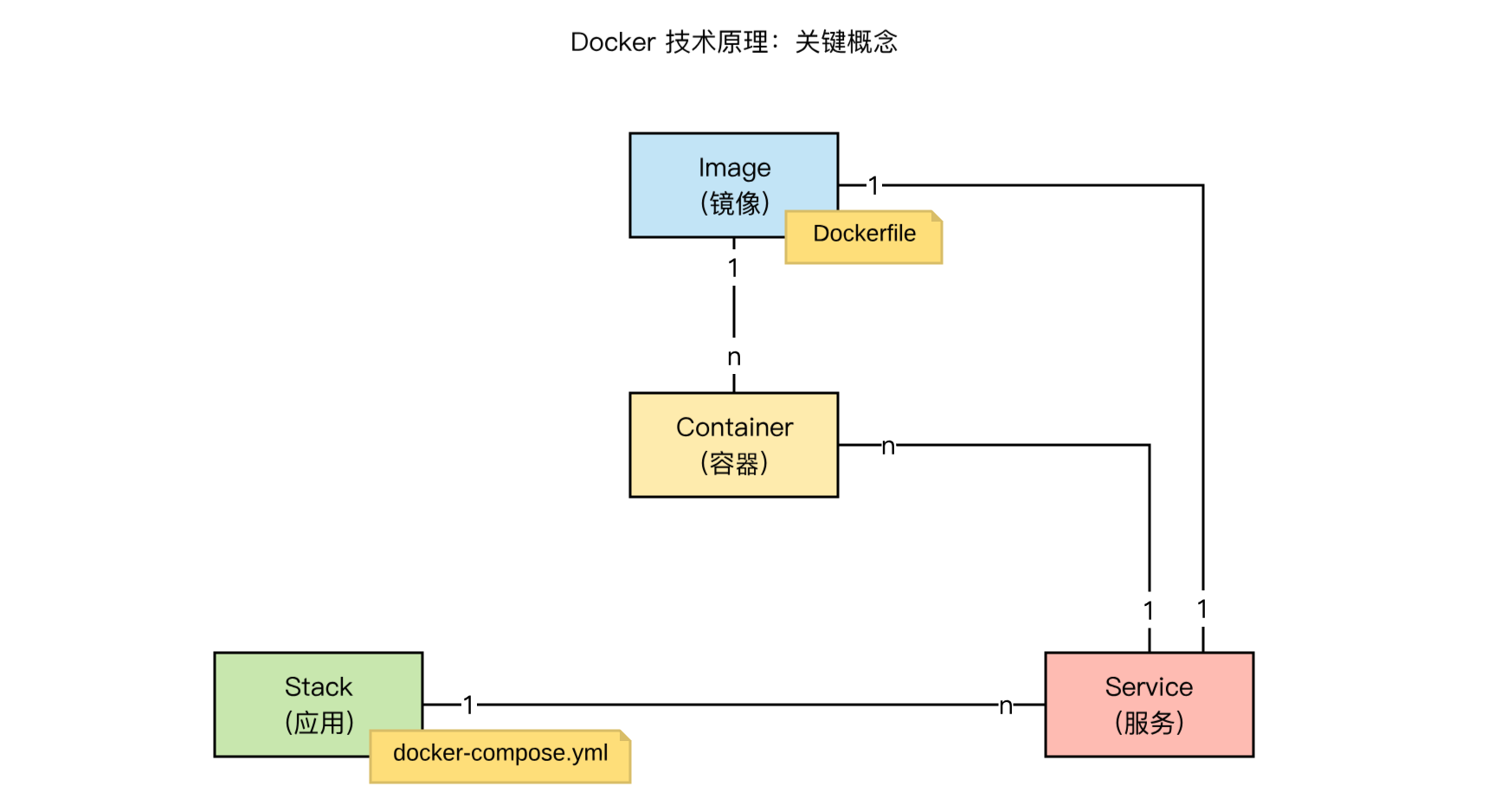Docker 系列:Docker 实践
2018-07-22
主要内容,几个方面:
- 构建:
- base image
- Dockerfile
- 运行:
- 资源限制
- 网络
- 集群:
- Swarm
- Kubernetes
1. 构建
1.1. base image
公司的 base image:
- https://company.io/common/alpine-oraclejdk8
说明:
- 基于 frolvlad/alpine-oraclejdk8:slim,增加了 bash、听云和 iothub 等基础设施
1.2. Dockerfile
问题:
- 每个镜像构建,都需要一个 Dockerfile 文件,为什么我们的应用中,没有写 Dockerfile 文件
实践:采用 docker-maven-plugin 插件,将 Docker 的构建流程跟 Maven 的生命周期绑定
- mvn package → docker build
- mvn deploy → docker push
具体 pom 中配置:(https://company.io/common/parent)
<plugin>
<groupId>com.spotify</groupId>
<artifactId>docker-maven-plugin</artifactId>
<version>1.0.0</version>
<configuration>
<imageName>${repo.docker}/${app.imagePath}</imageName>
<baseImage>${repo.docker}/infra/java:${java.version}</baseImage>
<workdir>/app</workdir>
<env>
<TZ>Asia/Shanghai</TZ>
<SPRING_APPLICATION_NAME>${project.artifactId}</SPRING_APPLICATION_NAME>
</env>
<entryPoint>["boot.sh", "${project.build.finalName}.${project.packaging}"]</entryPoint>
<resources>
<resource>
<targetPath>/app</targetPath>
<directory>${project.build.directory}</directory>
<include>${project.build.finalName}.${project.packaging}</include>
</resource>
</resources>
<runs>
<run>ln -snf /usr/share/zoneinfo/$TZ /etc/localtime</run>
<run>echo $TZ > /etc/timezone</run>
</runs>
<forceTags>true</forceTags>
<imageTags>
<imageTag>${project.version}</imageTag>
</imageTags>
</configuration>
<executions>
<execution>
<id>build-image</id>
<phase>package</phase>
<goals>
<goal>build</goal>
</goals>
</execution>
<execution>
<id>push-image</id>
<phase>deploy</phase>
<goals>
<goal>push</goal>
</goals>
</execution>
</executions>
</plugin>
<plugin>
<groupId>com.spotify</groupId>
<artifactId>dockerfile-maven-plugin</artifactId>
<version>1.4.0</version>
<configuration>
<repository>docker.company.io/${app.imagePath}</repository>
<tag>${project.version}</tag>
<buildArgs>
<JAR_FILE>${project.build.finalName}.jar</JAR_FILE>
</buildArgs>
<googleContainerRegistryEnabled>false</googleContainerRegistryEnabled>
</configuration>
<executions>
<execution>
<id>build-image</id>
<phase>package</phase>
<goals>
<goal>build</goal>
</goals>
</execution>
<execution>
<id>push-image</id>
<phase>deploy</phase>
<goals>
<goal>push</goal>
</goals>
</execution>
</executions>
</plugin>
上述插件的配置,生成 Dockerfile 内容如下:
FROM docker.company.io/common/alpine-oraclejdk8:1.2
ENV APP_HOME /opt
ENV SPRING_APPLICATION_NAME api ENV TZ Asia/Shanghai
WORKDIR /opt
ADD /opt/api.jar /opt/
RUN ln -snf /usr/share/zoneinfo/$TZ /etc/localtime RUN echo $TZ > /etc/timezone
ENTRYPOINT ["/opt/boot.sh", "/opt/api.jar"]
使用 docker-maven-plugin 的优缺点:
- 优点:
- 组件化,可继承复用
- 可以使用 pom 中定义的变量
- 缺点:
- 稳定性:非官方、个人开发,暂时不维护了
- 依赖 Maven 构建环境:不同机器的 maven 版本、jdk 版本有差异
使用纯 Docker 的多阶段构建,可以作为一种替代方案:
FROM maven:3.5-jdk-8 AS build-env
ADD . /src
WORKDIR /src
RUN mvn clean package
FROM docker.company.io/common/alpine-oraclejdk8:1.2
ENV APP_HOME /opt
ENV SPRING_APPLICATION_NAME api ENV TZ Asia/Shanghai
WORKDIR /opt
COPY --from=build-env /src/target/ares-blade.jar /opt/ares-bla RUN ln -snf /usr/share/zoneinfo/$TZ /etc/localtime
RUN echo $TZ > /etc/timezone
ENTRYPOINT ["/opt/boot.sh", "/opt/ares-blade.jar"]
纯 Docker 的多阶段构建,优点:
- 只依赖 Docker
- 不可变的构建环境:maven 版本、jdk 版本 都是指定的
2. 运行
2.1. 资源限制
几个主要问题:
- 资源限制和什么有关?
- 我们做了资源限制么?
- 为什么我们做了一些资源限制 or 为什么没做一些资源限制?
2.1.1. 资源限制,跟什么有关
在「单机容器」场景,Docker 、Docker Compose:
- CPU:一个容器,最多只能使用「限制数量的 CPU」
- 内存:容器内存申请,超过「限制的内存额度」时,容器会被 kill 掉(OOM Kill)
在「集群」场景,Swarm、Kubernetes:
- 容器,只会被分配到「足够资源的节点」
- 集群的容器分配算法:根据「节点的资源」和「容器申请的资源」,匹配到「合适的节点」
- 常用策略:均匀分布、优先占用
2.1.2. 资源限制,我们做了什么?
以 abacus/abacus-order 服务为例:https://git.company.io/abacus/abacus
- Swarm 模式,设置的资源限制
- Kubernetes 模式,设置的资源限制
内部实践的基本策略
Swarm 模式:(https://company.io/abacus/abacus/blob/master/docker-compose.prod.yml) resources.reservations 具体内容:
version: '3.3'
services:
order:
deploy:
replicas: 12
resources:
reservations:
cpus: '2'
Kubernetes 模式:(https://company.io/abacus/abacus/blob/master/abacus-prod.yaml) resources.requests 具体内容:
apiVersion: apps/v1
kind: Deployment
metadata:
name: abacus-order
spec:
replicas: 12
selector:
matchLabels:
app: abacus-order
template:
metadata:
labels:
app: abacus-order
spec:
containers:
- name: abacus-order
image: docker.company.io/abacus/abacus-order:2.0.18
imagePullPolicy: Always
resources:
requests:
cpu: "2000m"
readinessProbe:
httpGet:
path: /health
port: 8080
initialDelaySeconds: 35
periodSeconds: 5
livenessProbe:
httpGet:
path: /health
port: 8080
initialDelaySeconds: 60
periodSeconds: 5
ports:
- name: http
containerPort: 8080
env:
- name: SPRING_APPLICATION_INSTANCE
valueFrom:
fieldRef:
fieldPath: metadata.name
envFrom:
- configMapRef:
name: abacus-env-vars
volumeMounts:
- name: config
mountPath: /opt/config
- name: logs
mountPath: /opt/logs
volumes:
- name: config
hostPath:
path: /opt/config
- name: logs
hostPath:
path: /opt/logs
疑问:
- 上述 Kubernetes 的 Deployment 中 resources.requests.cpu 的 2000m 的含义? m 是什么含义?
- CPU 一般用核数来标识,一核CPU 相对于物理服务器的一个超线程核,也就是操作系统 /proc/cpuinfo 中列出来的核数。因为对资源进行了池化和虚拟化,因此 kubernetes 允许配置非整数个的核数,比如 0.5 是合法的,它标识应用可以使用半个 CPU 核的计算量。CPU 的请求有两种方式,一种是刚提到的 0.5,1 这种直接用数字标识 CPU 核心数;另外一种表示是 500m,它等价于 0.5,也就是说 1 Core = 1000m。
- 更多细节,参考:https://cizixs.com/2018/06/25/kubernetes-resource-management/
2.1.3. 为什么,没有限制内存
在 Docker 层面,限制「内存」:
- 优点:集群模式下,集群调度时,会考虑物理节点的「内存占用」因素,进行更合理的资源分配
- 缺点:容器申请的内存,超过「限制的内存大小」,则,容器会被直接 kill 掉(OOM kill)
JVM 层面,限制「内存」:
- 优点:
- 不用担心在 GC 之前,就发生 OOM kill
- 缺点:
- JVM 内存的限制,可能会遗漏一些特殊内存,例如直接内存等,导致内存泄露
- 集群模式下,会忽略「内存」因素,导致无法充分、合理利用集群的内存资源
因此,建议 Docker 层面、JVM 层面,都设置「内存」限制
- Docker 层面:设置「需要内存的下限」,集群模式中,采用 reservations、requests 等
- JVM 层面:进行精确的内存限制,
2.2. 网络
具体实践:

3. 集群
3.1. Swarm
3.1.1. Swarm 逻辑架构
具体逻辑架构:

3.1.2. Swarm 物理架构
Swarm 集群模式,物理架构:

其中,有一个很大的教训:
混布 Swarm Manager 的问题:
服务部署过程中, Swarm Manager 压力增大,会影响同一节点上的其他容器,容器一旦崩溃,会进一步增加 Swarm Manager 的压力
之前 Swarm Manager 同时支持 Swarm Worker 角色,导致 Swarm Manager 压力更大
3.2. Kubernetes
世纪之问:
为什么要从 Swarm 切换到 Kubernetes?从「容器化」走向「云原生」
术语简介:
- 容器化:只是运行在容器中,其他的都是老的方案和逻辑
- 云原生:容器部署、容器调度、甚至跟代码相关的完整生态
Kubernetes 新特性:
- Sidecar
- 服务注册和发现
- 配置中心
- 定时任务
- 调度亲和度
- Service Mesh
原文地址:https://ningg.top/docker-series-08-docker-summary-best-practise/